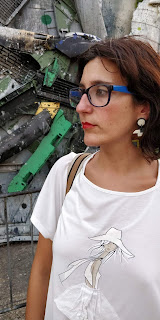August 18, 2018
BY Cláudia Paiva Silva 1
Comments
Considering the huge number of tourists up and down Lisbon, one may wonder if the city will not lose its typical light, the fascination among the small streets of Alfama, Mouraria, Bairro Alto, now filled with foreigners more than with locals. Can a person manage to "get lost" on purpose in the small alleys, backyards and "patios" when everyone is heading for the same tour guide scenarios?
It is however in that precise moment when we discover that there's more to see than the obvious and that the "tuk tuk" self-made man and woman do not know it all yet (and we must thank the gods for that).
There are still some quite exquisite places that even though can be meet & greet by everyone, not everybody (including the city natives) are familiarized with, and those are what cab be named as "urban jungles". Maybe it's too farfecthed but the city was not only created to support big buildings, vahicles, public transports. There are also beautiful gardnes and greenhouses where we can actually escape inside the turmoil but at the same time forget the world outside (a bit like Alice and the mirror).

(CML Archive - Parque Eduardo VII in the 30's)
The Lisbon Greenhouse (Estufa Fria) located at the Parque Eduardo VII was built on the location of a former basalt quarry dated from the 19th century. In 1912 one of the gardeners responsible for the new vegetation that was to decorate "Avenida da Liberdade" decided to create a shelter for the delicate plants that were being imported from all over the world. With the advent of the 1st World War, this plan was put on hold and the plants started taking root in the small sheltered place where they had been housed taking advantage of the mineral rich soils from basalt origin. In 1926 the painter and architect Raul Carapinha was surprised to find this pleasant space and thought it would be a good idea to establish a Greenhouse at the site. Four years later the project was completed and in 1933 it was officially inaugurated.

(Parque Eduardo VII in the 30's)
During the 40's the greenhouse suffered a few alterations was well as the park landscaping, and a new lake, entrance and a ball room (by Edgar Cardoso) were added to the infrastructure extending its area. Finally in 1975, the "Hothouse" (with tropical and equatorial plants) and the "Sweet House" (where the beautiful cactus lay) were open to the public by Pulido Garcia.
As a tourist myself I'm shamed of not knowing most of these gardens. If it's true that while we are young we don't care, it is also true that becoming an adult with strict timetables, schedules and more responsability laying in our shoulders we never seem to find "time" to enjoy ourselfs at this places.
I love being wonder. I mean I love getting surprised by places I visit and for sure the Greenhouse had that overwhelming effetc on me. After more than a century after its opening it makes even more sense its presence in a city like Lisbon. In the 40´s and 50´s the capital limits to the "região saloia" ended up there. After that limit only farms and fields were seen until what the eye could reach in the horizon.
Today that region corresponds to the suburbs and it became imperative to have a loophole to run from the imense craziness, noise, confusion of every day living or surviving.
Inside the Greenhouse the architectural impact is huge. The obvious luxurious green in high contrast with the ceiling wooden rips that provide the proper light and temperature conditions for plants, trees and unusual flowers to grow and develop is quite a sight, and the feeling of entering into a tropical forest is imense.
Don't forget that it's an open ceiling so it really pours inside when it rains and it can get extremely hot in high temperature days. Apart from that advice, I will return several times. It's free sunday and holiday mornings so it's impossible not going there.
An attraction and bond was created. It will remain.











